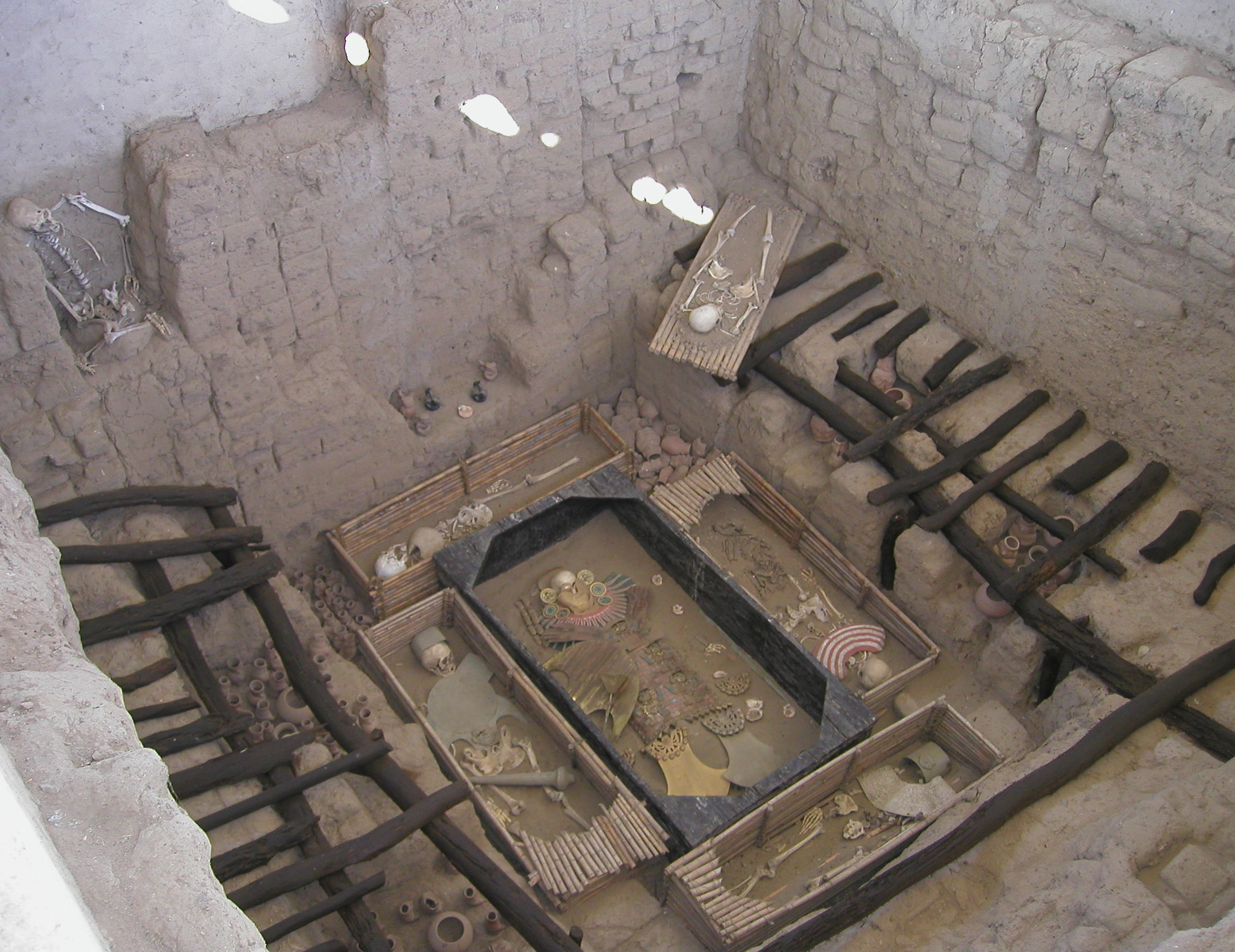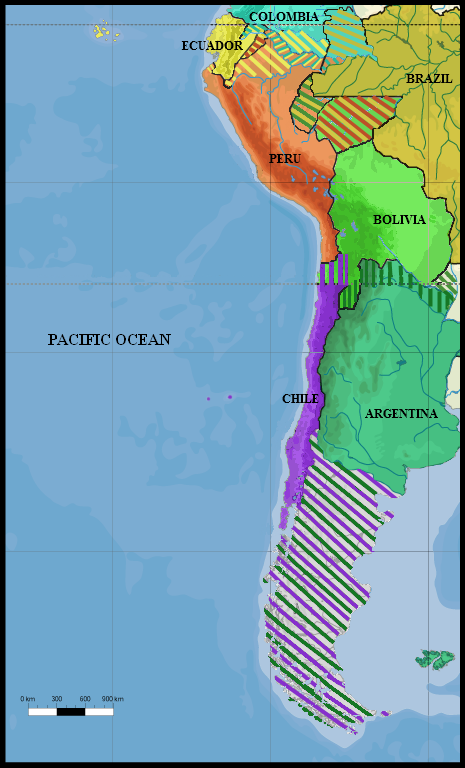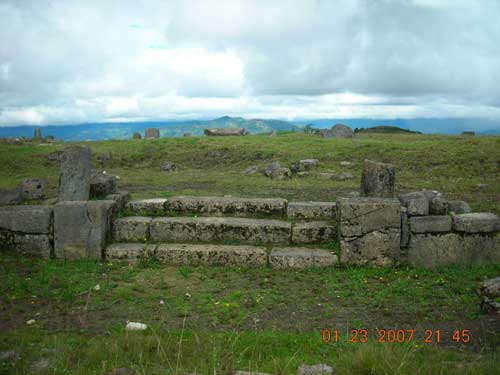|
Chota, Peru
Chota is a town in Northern Peru, capital of the province Chota in the region Cajamarca. The city is the seat of the Territorial Prelature of Chota. History Pre-Spanish history Chota's history dates back to pre-Inca times; it was a part of the Cajamarca kingdom. The local region has various archaeological remains which suggest that the area supported a dense population. Additionally, locations such as Pacopampa, Negropampa, Rejopampa and others are evidence of influence by the Chavin, Wari and Moche cultures. At various times it was also occupied by cultures such as Los Huambos in the west and Cuismanco in the east. In the mid-15th century, Túpac Yupanqui assimilated the area into the Inca empire. The city of Chota was first founded as "All Saints of Chota" on 1 November 1552 by Father Juan Ramírez; it is located south-west of present-day Chota. From Spanish colonization During the War of the Pacific, after the Battle of San Pablo the Araucanian (from the city of ... [...More Info...] [...Related Items...] OR: [Wikipedia] [Google] [Baidu] |
Regions Of Peru
According to the ''Organic Law of Regional Governments'', the regions () are, with the departments, the first-level semi autonomous administrative subdivisions of Peru. Since its Peruvian War of Independence, 1821 independence, Peru had been divided into departments of Peru, departments (Regions) Peru’s 24 departments each have a regional government and legislature responsible for administration, economic planning, and public services. These governments operate with autonomy while still coordinating with national authorities. Each department is led by a regional governor, who is elected by popular vote for a four-year term. The governor is responsible for implementing regional policies, managing budgets, and overseeing infrastructure projects. Supporting the governor is the regional legislative council, composed of elected representatives from different provinces within the department. This council approves budgets, monitors public investments, and ensures government accountab ... [...More Info...] [...Related Items...] OR: [Wikipedia] [Google] [Baidu] |
Wari Culture
The Wari () were a Pre-Inca cultures, Middle Horizon civilization that flourished in the south-central Andes and coastal area of modern-day Peru, from about 500 to 1000 AD. Wari ruins, Wari, as the former capital city was called, is located north-east of the modern city of Ayacucho, Peru. This city was the center of a civilization that covered much of the highlands and coast of modern Peru. The best-preserved remnants, besides the Huari, Wari ruins, are the recently discovered Cerro Pátapo ruins, Northern Wari ruins near the city of Chiclayo, Peru, Chiclayo, and Cerro Baúl in Moquegua. Also well-known are the Wari ruins of Pikillaqta ("Flea Town"), a short distance south-east of Cuzco ''en route'' to Lake Titicaca. However, there is still a debate whether the Wari dominated the Central Coast or the polities on the Central Coast were commercial states capable of interacting with the Wari people without being politically dominated by them. History Archaeological evidence poin ... [...More Info...] [...Related Items...] OR: [Wikipedia] [Google] [Baidu] |
El Niño
EL, El or el may refer to: Arts and entertainment Fictional entities * El, a character from the manga series ''Shugo Chara!'' by Peach-Pit * Eleven (''Stranger Things'') (El), a fictional character in the TV series ''Stranger Things'' * El, family name of Kal-El (Superman) and his father Jor-El in the Superman dynasty * E.L. Faldt, character in the road comedy film '' Road Trip'' Music * Él Records, an independent record label from the UK founded by Mike Alway * ''Él ''(Lucerito album), a 1982 album by Lucerito * "Él", Spanish song by Rubén Blades from the album '' Caminando'' * "Él" (Lucía song), the Spanish entry performed by Lucía in the Eurovision Song Contest 1982 Other media * ''Él'', 1926 autobiographical novel by Mercedes Pinto * ''Él'' (film), a 1953 film by Luis Buñuel based on the 1926 novel * ''Él'' (visual novel), a 1991 Japanese adult visual novel * EL TV, an Azerbaijani regional television channel Companies and organizations * Estée Lauder Co ... [...More Info...] [...Related Items...] OR: [Wikipedia] [Google] [Baidu] |
Amazon Basin
The Amazon basin is the part of South America drained by the Amazon River and its tributary, tributaries. The Amazon drainage basin covers an area of about , or about 35.5 percent of the South American continent. It is located in the countries of Bolivia, Brazil, Colombia, Ecuador, Guyana, Peru, Suriname, and Venezuela, as well as the territory of French Guiana. Most of the basin is covered by the Amazon rainforest, also known as Amazon rainforest, Amazonia. With a area of dense tropical forest, it is the largest rainforest in the world. Geography The Amazon River begins in the Andes, Andes Mountains at the west of the basin with its main tributary the Marañón River and Apurímac River, Apurimac River in Peru. The highest point in the Drainage divide, watershed of the Amazon is the second biggest peak of Yerupajá at . The Amazon River Basin occupies the entire central and eastern area of South America, lying to the east of the Andes mountain range and extending from th ... [...More Info...] [...Related Items...] OR: [Wikipedia] [Google] [Baidu] |
Chiclayo
Chiclayo (; mochica language, Mochica: ''Cɥiclaiæp'') is the principal city and capital of the Lambayeque region and Chiclayo Province in northern Peru. It is located from the Pacific coast, from the city of Trujillo, Peru, Trujillo, and from the country's capital, Lima. The city was originally founded by Spanish priests as "Santa María de los Valles de Chiclayo" in the 16th century, acting as a small town of passage and rest of travelers. It was declared an official city on 15 April 1835 by president Felipe Santiago Salaverry. He named Chiclayo "the Heroic City" to recognize the courage of its citizens in the fight for independence, a title it still holds. Other nicknames for Chiclayo include "The Capital of Friendship" and the "Pearl of the North", due to its kind and friendly nature of its people. Chiclayo is Peru's List of 20 largest cities in Peru, fourth-largest city, after Lima, Arequipa, and Trujillo, with a population of 738,000 as of 2011. [...More Info...] [...Related Items...] OR: [Wikipedia] [Google] [Baidu] |
Arauco, Chile
Arauco is a city and commune () in Chile, located in Arauco Province in the Bío Bío Region. The meaning of Arauco means Chalky Water in Mapudungun. The region was a Moluche aillarehue. The Spanish settlements founded here during the Conquest of Chile were destroyed on numerous occasions by the Mapuche during the Arauco War. History Old Arauco In 1552 Pedro de Valdivia the first governor of Chile, founded a fort, named ''San Felipe de Rauco'' or ''de Araucan''. It was east of the location of the modern city of Arauco in the part of the valley immediately on the South or left bank of the Carampangue River at the point where on the opposite bank it receives the riachuelo of Conumo. Valdivia planned it to be the base for a city he planned to found. The Mapuche destroyed the fort in 1554, after killing Valdivia's insane mother-in-law. It was raised again after the battle of Quiapo, by García Hurtado de Mendoza in 1559. Destroyed again in 1563 it was rebuilt agai ... [...More Info...] [...Related Items...] OR: [Wikipedia] [Google] [Baidu] |
Battle Of San Pablo
A battle is an occurrence of combat in warfare between opposing military units of any number or size. A war usually consists of multiple battles. In general, a battle is a military engagement that is well defined in duration, area, and force commitment. An engagement with only limited commitment between the forces and without decisive results is sometimes called a skirmish. The word "battle" can also be used infrequently to refer to an entire operational campaign, although this usage greatly diverges from its conventional or customary meaning. Generally, the word "battle" is used for such campaigns if referring to a protracted combat encounter in which either one or both of the combatants had the same methods, resources, and strategic objectives throughout the encounter. Some prominent examples of this would be the Battle of the Atlantic, Battle of Britain, and the Battle of France, all in World War II. Wars and military campaigns are guided by military strategy, whereas batt ... [...More Info...] [...Related Items...] OR: [Wikipedia] [Google] [Baidu] |
War Of The Pacific
The War of the Pacific (), also known by War of the Pacific#Etymology, multiple other names, was a war between Chile and a Treaty of Defensive Alliance (Bolivia–Peru), Bolivian–Peruvian alliance from 1879 to 1884. Fought over Atacama Desert border dispute, Chilean claims on Litoral Department, coastal Bolivian territory in the Atacama Desert, the war ended with victory for Chile, which gained a significant amount of resource-rich territory from Peru and Bolivia. The direct cause of the war was a nitrate taxation dispute between Bolivia and Chile, with Peru being drawn in due to its secret alliance with Bolivia. Some historians have pointed to deeper origins of the war, such as the interest of Chile and Peru in the nitrate business, a long-standing rivalry between Chile and Peru for regional hegemony, as well as the political and economical disparities between the stability of Chile and the volatility of Peru and Bolivia. In February 1878, Bolivia increased taxes on the Chile ... [...More Info...] [...Related Items...] OR: [Wikipedia] [Google] [Baidu] |
Moche Culture
The Moche civilization (; alternatively, the Moche culture or the Early, Pre- or Proto-Chimú culture, Chimú) flourished in northern Peru with its capital near present-day Moche, Trujillo, Peru from about 100 to 800 AD during the Cultural periods of Peru, Regional Development Epoch. While this issue is the subject of some debate, many scholars contend that the Moche were not politically organized as a monolithic empire or state. Rather, they were likely a group of autonomous polities that shared a common culture, as seen in the rich iconography and monumental architecture that survives today. Background Moche society was agriculturally based, with a significant level of investment in the construction of a sophisticated network of irrigation canals for the diversion of river water to supply their crops. Their artifacts express their lives, with detailed scenes of hunting, fishing, fighting, sacrifice, sexual encounters, and elaborate ceremonies. The Moche are particularly note ... [...More Info...] [...Related Items...] OR: [Wikipedia] [Google] [Baidu] |
Chavín Culture
The Chavín culture was a Pre-Columbian era, pre-Columbian civilization, developed in the northern Andean highlands of Peru around 900 BCE, ending around 250 BCE. It extended its influence to other civilizations along the Peruvian coast.Burger, Richard L. 2008 "Chavin de Huantar and its Sphere of Influence", In ''Handbook of South American Archeology'', edited by H. Silverman and W. Isbell. New York: Springer, pp. 681–706Burger, Richard L., and Nikolaas J. Van Der Merwe (1990). "Maize and the Origin of Highland Chavín Civilization: An Isotopic Perspective", ''American Anthropologist'' 92(1):85–95. The Chavín people (whose name for themselves is unknown) were located in the Mosna Valley where the Huari District, Mosna and Huachecsa river, Huachecsa rivers merge. This area is above sea level and encompasses the ''Quechua (geography), quechua'', ''suni (geography), suni'', and ''puna grassland, puna'' life zones.Burger (1992), ''Chavin and the Origins of Andean Civilization'' ... [...More Info...] [...Related Items...] OR: [Wikipedia] [Google] [Baidu] |
Cajamarca Region
Cajamarca (; ; ) is a department and region in Peru. The capital is the city of Cajamarca. It is located in the north part of the country and shares a border with Ecuador. The city has an elevation of above sea level in the Andes Mountain Range, the longest mountain range in the world. Part of its territory includes the Amazon Rainforest, the largest in the world. History The oldest known irrigation canals in the Americas are located in the Nanchoc District of Cajamarca Department. The canals in the Zaña Valley have been radiocarbon dated to 3400 BCE, and possibly date to 4700 BCE. From the 6th to the 10th century the people of the Wari culture ruled earlier cultures in the highlands. They established the administrative center of Wiraquchapampa. In the 15th century, the Incas conquered the territory, expanding their empire. They established their regional capital in what is now Cajamarca. The Incas in 1465 established a new province there to serve as a bridge to their la ... [...More Info...] [...Related Items...] OR: [Wikipedia] [Google] [Baidu] |
Pacopampa
Pacopampa () is an archaeological site located in the northern highlands of Peru, in the department of Cajamarca. It presents the remains of a monumental ceremonial center, made with cut and polished stone. It belongs to the Formative period, dating from 1200 to 500 BC. The land where the reservoir extends belongs to the National University of San Marcos, which through its ''Rural Andean History Seminar'' cares permanently for the monument. Geographical location It is within the village of Pacopampa at 2140 m in the Querocoto District of the province of Chota, Cajamarca Region. It is among the largest ceremonial centers of the northern highlands of Peru. At its surroundings a dozen of archaeological sites have been identified, which a couple have been studied. These are called Chapel and El Mirador, located one kilometer east. Further, 3 km southeast, is Pandanche another Formative period ceremonial center. Research In the 1930s Rafael Larco Hoyle visited the area wher ... [...More Info...] [...Related Items...] OR: [Wikipedia] [Google] [Baidu] |







